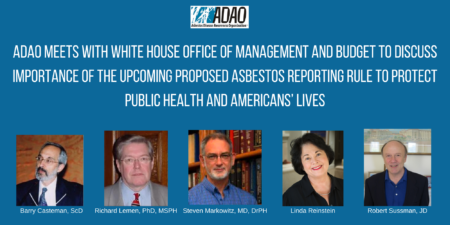Posted on March 18, 2022

The Asbestos Disease Awareness Organization (ADAO) was pleased to present comments today to the White House Office of Management and Budget (OMB) about the upcoming Environmental Protection Agency’s (EPA) proposal of section 8(a) reporting and recordkeeping requirements for asbestos under the Toxic Substances Control Act (TSCA). When final, this rule will be an important and overdue step in affirming Americans’ “Right to Know” where and how asbestos is imported and used in this country. It will also assure that EPA has the critical information it needs to prevent harmful exposure to asbestos under TSCA.
At today’s meeting, ADAO pushed for broad and effective reporting requirements to implement the agreement, with no loopholes or exemptions. To maximize compliance with the new rule, ADAO recommended that EPA conduct aggressive outreach to educate industry about their reporting obligations, report to Congress on information submitted and disclose reports to the public to the maximum extent permitted by law.
As we all know too well, there is no safe level of asbestos exposure, and the only way to prevent asbestos-caused illnesses such as mesothelioma, lung cancer and asbestosis is to eliminate exposure. Without knowledge of where and how asbestos and asbestos-containing products are used and imported, effective protection against this deadly carcinogen is impossible.
Meeting presenters on behalf of ADAO included Barry Castleman, ScD; Richard Lemen, PhD, MSPH; Steven Markowitz, MD, DrPH; Linda Reinstein, ADAO President; and Bob Sussman, ADAO Counsel.
“Disclosure is key to our fight against asbestos-caused illnesses and death,” said Linda Reinstein, ADAO’s president and a mesothelioma widow. “This rule will require the Chlor-alkali industry and other companies to report their asbestos imports and use. EPA needs this critical information to comprehensively evaluate asbestos risk and draft a risk management rule. Without industry accountability and transparency, Americans will remain at risk. ADAO is proud to take another landmark step forward to prevent exposure to eliminate all asbestos-caused diseases.”
“From 1991 to 2021, more than one million Americans have died from preventable asbestos-caused diseases,” Reinstein continued. “That is why ADAO and its members asked for today’s meeting: to make clear that despite reductions in use, asbestos continues to kill nearly 40,000 Americans each year and we can only prevent these deaths if we know how Americans are exposed. The man-made disaster that is asbestos contributes directly to environmental racism, as those most affected by exposure are historically from the working class and underserved communities.”
Bob Sussman, ADAO counsel emphasized that “EPA is at a critical stage in its work on asbestos under TSCA and the reporting rule will help develop information that supports better public health protection. An improved understanding of use and exposure for conditions of use (COUs) like chlor-alkali production addressed in the Part 1 risk evaluation should inform the upcoming risk management rulemaking. Likewise, information about COUs overlooked in Part I (including articles or contaminated talc or other products) should enable EPA to address these sources of exposure in its Part 2 risk evaluation,” explained Sussman.
ADAO has pushed for a reporting rule under TSCA for years. In 2018, ADAO and five public health groups petitioned EPA to require asbestos reporting but EPA denied the petition. Petitioners then sued EPA. On December 22, 2020, Judge Chen (N.D. Cal.) found that the petition denial “runs contrary to EPA’s obligation to collect reasonably available information to inform and facilitate its regulatory obligations under TSCA.” As a result, Judge Chen stated that EPA has “little information …about the quantities of asbestos-containing products in the U.S. chain of commerce and the overall consumer and occupational exposure for downstream uses of asbestos.” He then ordered EPA to require reporting to “address the information-gathering deficiencies identified” in his decision.
After Judge Chen’s decision, ADAO entered into an agreement with EPA committing the Agency to propose a rule requiring reporting of:
- Importation and use of raw asbestos
- Importation and use asbestos-containing mixtures and articles
- Processing of raw asbestos and articles and mixtures
- Presence of asbestos contaminants in other substances and mixtures (including talc)
EPA is now required to propose the rule by April 14.
This is not the first-time asbestos reporting has been considered. The Asbestos Information Act of 1988, required asbestos or asbestos-containing material manufacturers to report to the EPA Administrator. The Act also required the EPA Administrator to then publish this information for the public.
